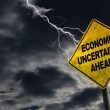by Kristina Hooper, Chief Global Strategist, Invesco Canada
Weekly Market Compass: As we enter a new lunar year, the U.S. Federal Reserve reiterates its stance on inflation and stimulus
We have just begun a new lunar year — the Year of the Ox. I think we are all happy to have said goodbye to the Year of the Rat — although I suppose we should have known this last lunar year was going to be bad because the Year of the Rat is traditionally considered to be a year of turbulence in which change or disaster can happen. Interestingly, the rat and the ox have an unusual relationship. As some of you already know, according to ancient mythology, many animals were in a Great Race to become the 12 animals chosen as the royal guard, which would then comprise the Chinese zodiac. The rat was unable to cross the river and so would not have been able to finish the race but tricked the ox into letting it ride on its back. Just as the ox was getting to the shore, the rat jumped off his back and beat the ox for first place. That is why the ox is the second animal in the zodiac sequence rather than the first.
The good news is that the Year of the Ox is traditionally viewed as calm, stable, and economically prosperous. The ox is strong and powerful. The ox is a hard worker. And the ox is active and moving. I am hopeful the ox is a metaphor for a global economy that gets moving again this year and proves to be strong and powerful, as populations are vaccinated and life begins to return to normal.
But this is not just the Year of the Ox. There are five elements associated with each animal — fire, earth, metal, wood, and water — and this is a year in which the element is metal. In Chinese Taoist thought, metal attributes include firmness, resilience, persistence, and determination. I hope these are the traits we see this year in the global economy — that it remains resilient, despite COVID-19 headwinds, until vaccines are broadly distributed. And maybe — just maybe — metal might symbolize the many syringes that will distribute the vaccine needed to achieve herd immunity and re-open economies. And so with that, let me wish everyone a happy lunar new year!
The U.S. Federal Reserve reiterates its messaging on inflation and stimulus
One of the big news items last week was the speech from the U.S. Federal Reserve (the Fed) Chair Jay Powell to the Economic Club of New York. Powell continued with the same two themes we have heard in other recent speeches: 1) inflation is not a significant risk at this time, and 2) the Fed will remain extremely accommodative.
In supporting his first point, Powell reminded us of how much tighter the labour market was in February 2020 and yet inflation was relatively low. He explained, “There was every reason to expect that the labour market could have strengthened even further without causing a worrisome increase in inflation were it not for the onset of the pandemic.” In his speech, Powell emphatically pushed back on the idea that the economy might overheat with additional stimulus. He said it could take “many years” to overcome all the economic scarring caused by the pandemic.1
In terms of his second point, Powell stressed that the Fed would be “patiently accommodative”, having learned from mistakes made in the past. He stressed that maximum employment is a “broad and inclusive goal” and he showed real concern for the difficult labour market conditions of “the most economically vulnerable Americans.” He called for more fiscal stimulus and assured that the Fed would maintain very accommodative policy to support the recovery. Powell reinforced key points from his press conference following the last Federal Open Market Committee meeting.
Despite Powell’s repeated reassurances, the yield on the 10-year U.S. Treasury rose to its highest level since last March, suggesting to many that inflation expectations have risen significantly. Because there are multiple factors influencing the yield on Treasuries, I prefer to follow the breakeven inflation rate — the spread between the 10-year U.S. Treasury yield and the 10-year Treasury Inflation Protected Securities (TIPS) yield. And yes, that spread has risen significantly in the past year to 2.21% — a level we haven’t seen in far more than a year — from a low of 0.50% on March 19, 2020.2 However, when I look back at the global financial crisis, the breakeven inflation rate went from a low of 0.04% in November 2008 to 2.37% in December 2009, suggesting concerns that inflation would rise substantially.2 The spread rose further in the ensuing years but proved to be a terrible predictor of inflation. Perhaps the same could happen again. And even if inflation were to spike very substantially, the Fed appears poised to view it as transitory and maintain its very accommodative stance.
Diversification may help cushion the risks facing today’s portfolios
Despite last week’s blog — or perhaps because of it — I continue to hear concerns about the stock market being in a bubble. To be clear, I remain positive about risk assets such as stocks, convertible bonds, high yield bonds and investment grade credit because of the monetary policy backdrop and because I expect a strong economic rebound this year. Yes, there are corners of the investing universe that could be in speculative bubbles, and there are parts of the stock market that have stretched valuations. And there is the real potential for a stock market correction in the near term — although I believe it would be viewed as an investment opportunity in this extremely risk asset-friendly monetary policy environment. I also recognize that sometimes recoveries from the bursting of a bubble can be long and drawn out, as we saw with Japanese stocks that peaked in 1989 and have yet to fully recover in price terms.
But that is why I believe broad diversification within and across asset classes is so important; it helps moderate the impact of serious risks facing portfolios, such as the risk of a correction, inflation risk, and interest rate risk. Maintaining a long-term perspective, being well-diversified, adhering to an investment policy statement, and being disciplined and unemotional can all sound very boring in a world of skyrocketing cryptocurrencies and Reddit millionaires, but I believe it is necessary in order to achieve long-term investment goals.
This post was first published at the official blog of Invesco Canada.














